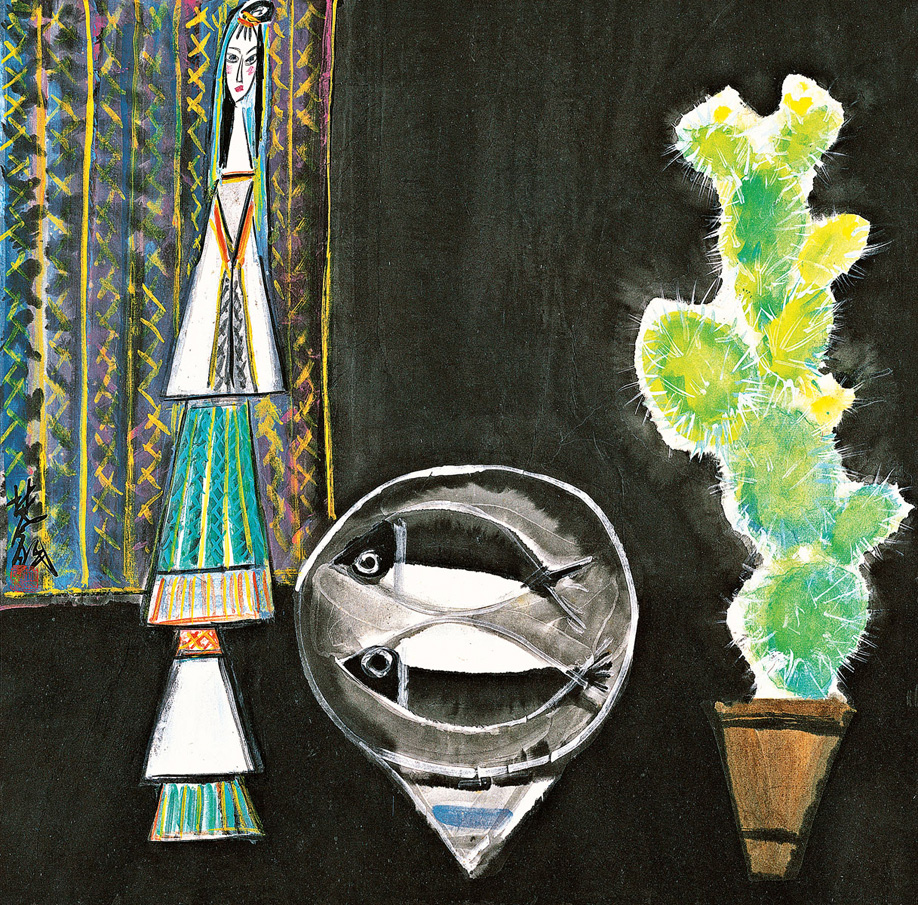Lin Fengmian's paintings throughout his life were mainly landscapes, opera characters, lady figures, flowers, birds and still lifes. Lin's still lifes are quite rare but they reflect the most straightforward part of Lin Fengmian's character. His still lifes are considered to be his "most western" compositions. "Still life" as an art form has existed since ancient times, from the tomb art of ancient Greece and Egypt where it appeared in the form of religious and fable representations, In modern Western art history "Still Life" became established in the 17th century, and thanks to the efforts of Dutch painters, it was much improved in the mid-19th century. Subsequently influenced by impressionism and symbolism in the late 19th century, and by fauvism, expressionism, surrealism and others in the 20th century, "Still Life" became far more colorful and splendid. "Still Life" is not a prominent category in Chinese art. Traditional Chinese paintings mainly concentrate on mountains and water. Chinese "Still Life" usually falls to the concept of "flowers and birds", which depicts flowers, insects, grass, birds, animals and other natural beings and objects. Western "Still Life", however, highlights realistic and factual description of objects, which don't have to be living; Inanimate objects may also be represented in Western paintings. This reflects a value difference between Chinese and Western paintings.
As the most significant art educator in the 20th century in China, Lin Fengmian had been inspired by Western art early in his career. From 1919, he lived and studied in Europe first France then Germany on a work-study basis. He studied in the Ecole des Beaux-Arts de Dijon, where his talent was recognized and encouraged by Ovid Yencesse (1869-1947), Director of the Ecole. Later, Lin studied at Ecole des Beaux-Arts de Paris in "l'atelier de Cormon", Corman's Art Studio, where he learned realistic painting skills. Yencesse suggested that Lin should broaden his field of study, especially in traditional Chinese arts. For this reason, Lin shuttled back and forth between various large museums. Lin most frequently visited Musée Guimet of Eastern Art and Musée National de la Céramique, the national museum of ceramics. Western modern masters such as Matisse were also learning and absorbing from ideas and concepts from Eastern art. Lin Fengmian, as a Chinese, cherished the value of traditional art. The Chinese carvings, art and crafts, and drawings collected by European museums deeply influenced Lin's later art compositions. In addition, northern European expressionism, which Lin embraced when he was travelling and studying in Berlin enriched the diversity of his oil paintings.
The painting "Still Life, Figure, Fish, Cactus", painted around 1977, combines the two major themes of still life and figure. It integrates Chinese traditional art and Western cubism. Lin's square arrangement with round shapes in the picture fully displays Lin's painting style. It was painted with Chinese brush. The succinct brushmanship, fresh colors and rich composition constitute the typical features of Lin Fengmian's still life paintings. The ink-painted black background is borrowed from the character of lacquer painting, a traditional Chinese handicrafts art with a long history. The two-dimensional formative design, the balanced arrangement, the colorful fauvistic patterned window-curtains, the Near-East style, and the space implied by the position of the curtains, all reflect the freehand style of traditional Chinese brushwork and the modern style of Western paintings.
The female figure on the left is composed of multiple triangles, including her accessories and clothes, which are of traditional Chinese paper cutting. Even her nose and neck are triangular. The figure shows interesting shadow patterns with black background. According to documentary photos, similar pictures of such a figure were hung on the wall of Lin's residence on Nanchang Road when he lived in Shanghai. Lin particularly refers the figure in this still life to that image on his wall. The proportion of the cactus on the right is deliberately magnified to emphasize the verdure color and vitality of the plant. The round shapes on the right respond to the triangles on the left, and echo the round black-and-white fish plate in the middle. The plate is round-shaped with a triangular leg. The two fish are composed of circles and triangles, forming an interesting contradiction and balance.
According to current documentation, there are two paintings of similar composition where Lin Fengmian selected the elements of female figure, fish plate and cactus. One appears on P. 75 in "Lin Fengmian, Innovation Pioneer of Chinese Painting" (written by Shiy De-jinn, and published by Hsiung Shih Art Book Pte. Ltd), titled as "Still Life" (unknown size). The pattern of the women's clothes and the shape of the plates are slightly different. These two paintings are probably twin paintings composed at the same period. "Still Life, Figure, Fish ,Cactus" in the auction belonged for many years to the owner of San Huai House in Hong Kong, who is a well-known collector of Lin Fengmian works. A photo of this painting, plate 121, appears in "Modern Artists Theory, Work, Biography: Lin Fengmian" in 1988 with a preface by Lü Meng and compiled by Zhu Pu. It is titled "Still Life". Lü Meng was also born into an artist's family, and was Lin Fengmian's confidant. He was the first President of the Shanghai Lin Fengmian Art Research Association. Lü wrote the preface of many of Lin's albums. Zhu Pu was the Vice-President of the Association. Not many of Lin's paintings are collected in this book, and thus the significance of this painting:"Still Life, Figure, Fish, Cactus" is clearly emphasized.
